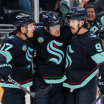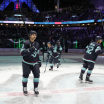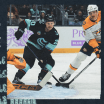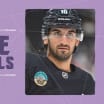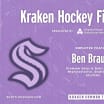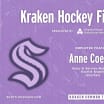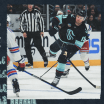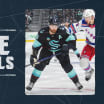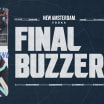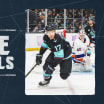During this inaugural season, it's typical to talk about players returning to face former teams. Saturday, when the Kraken face off against the Capitals, another important member of the Seattle organization, head video analyst Tim Ohashi, is back at his former rink.
'Role' the Tape
Kraken head video analyst Tim Ohashi returns to his former arena Saturday. He and colleague Brady Morgan will make thousands of individual clips for team use during the game
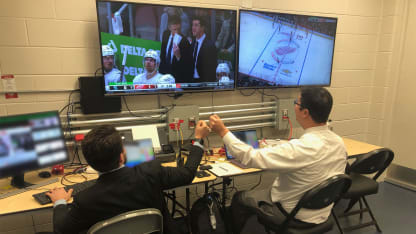
Ohashi, a video analyst with the Washington Capitals for five years, including their Stanley Cup title season in 2018, isn't a face you see behind the benches. But he plays an integral role within the hockey operations team. Since joining Seattle in 2020, he, along with video assistant Brady Morgan, embrace a primary focus to fuse the so-called eye test with advanced data for better analysis and coaching.
"I'm working with anything related to video," Ohashi said during a recent conversation. "And a lot of analysis when it comes to blending that video and the analytics (or numbers and data) that we get both from our internal team led by [director of hockey strategy and research] Alexandra Mandrycky and some other data sources we have access to."
So, what does that look like?
It can mean anything from pre-scouting upcoming opponents - for whom Ohashi and Morgan will watch and study multiple games scouting special teams, 5-on-5 play, faceoffs and more - to finding the kinds of clips the video team knows coaches want for instruction with players. When appropriate, data-driven information is blended in to prepare coaches and players for what they will see in a game.
What's been just as important to Ohashi is building the communication networks that make sure everyone involved gets the information they want in the form that makes it most usable or applicable. It's been a point of emphasis when working with six new coaches and 23 players on the active rosters, plus the various reserves who have appeared in Kraken games via American Hockey League callups and waivers acquisitions.
"I think it starts with a lot of questions and a lot of listening," Ohashi said. "I try as much as I can listen to what those around me are saying and pick up on the nuance and detail of what they value … what they find important.
"That makes me a little bit more aware those might be the kinds of clips they might be interested in. Or it might be an area of the game they particularly value. Certainly, I'm not afraid to just ask them questions. If I'm not clear on why they liked one clip or not another clip, the easiest way to get any answers is to be direct."
There's not a lot of free time for Ohashi and Morgan, that's for sure, but there may be no more demanding time than the hours every Kraken game demands.
Home or away, the two sit in the coaches' office in the arena, hearing the noise from the crowd as they tirelessly process information from multiple video screens and data sources.
Ohashi says he makes more than 1,000 clips per game on everything from breakouts, forecheck, and faceoffs to shot attempts, scoring chances and goalie handles. It all needs to be accessible for review of plays or individual shifts during intermission, post-game or whenever needed.
"Contrary to popular belief, we actually don't see the game with our own eyes," Ohashi said. "We watch them on screen. There's a bunch of angles so we get to see it in real time and from different angles and probably from a better view than from the bench. But it's different."
The goal is to be able to see as many of the 10 skaters on the ice as possible to understand the complete picture of what is happening on the ice, plus detailed angles over the crease or along the blue lines.
While there are league requirements for what equipment must be available in the coaches' office in every arena, Ohashi and Morgan also travel with a big trunk of gear from city to city. That way they are sure to have what they need - down to the ability to send video wirelessly to the bench -- as needed.
"We have an unbelievable equipment staff," Ohashi said in salute to colleagues who get gear from city to city.
Every bit of work Ohashi does is valuable, but it's most magnified when applied to a coaches' challenge.
When it comes to offside, Ohashi and Morgan are already watching every single zone entry, and there can be communication with the bench - initiated by either the video coaches or Dave Hakstol and his assistant coaches - as to whether a team is onside or not.
"[In the NHL], we're probably on the upper end of 90-percent where [officials] don't miss [offside calls]." Ohashi said. "But you want to double-check because the one they do miss, if [the puck] goes in, can be a big turning point ... everyone likes to confirm and make sure nobody missed anything.
"In an ideal world, we [Ohashi and Morgan] know the play was offside before the puck goes in the net. If it does happen to go in, then the bench already knows."
All of this came to bear in Hakstol's first challenge of the season Dec. 1 in Detroit when the Red Wings thought they had the first goal of the game.
0-1 #SeaKraken go down to DET but the score is being reviewed for offside pic.twitter.com/pWHm1mMyHI
— Alison (@AlisonL) December 2, 2021
The turnaround time to challenge is short and intense. You have about 20 to 30 seconds "which sounds like a lot, but it isn't," Hakstol said after the Detroit game, "to watch the video, watch replays, communicate with the bench and rapidly make a decision."
Sometimes the video coaches are looking for multiple things. Was there an offside and a goaltender interference? On top of that, even with 10-plus camera angles, sometimes the view of a puck is blocked by a skate, or a linesman is in front of a camera. But the Detroit transgression was crystal clear.
Another look at the Red Wings offside that negated the goal #SeaKraken pic.twitter.com/NYhDGUc6yG
— Alison (@AlisonL) December 2, 2021
"We noticed right away it was offside," Ohashi said. "Brady radioed in, 'Hey, this is offside. We should challenge.' Just very definitive. This was one Brady and I felt 100-percent 'this is offside, there's no gray area.'"
The final decision on any challenge is Hakstol's and he went with his video team. Their call was correct. The Detroit goal came off the scoreboard.
"Those guys did a great job of seeing (the offside) right away and also gaining information and getting the right picture to us right away on the bench," Hakstol said. "That's not always easy … those guys did a great job."
Is that something to celebrate? Not with a game going on. Ohashi says there's usually more of a sense of relief.
"I don't think there's many worse feelings for a video coach than watching your team on the penalty kill, knowing your suggestion or encouragement to challenge is the reason why there's guys out there trying to block shots, having to make saves," Ohashi said. "You just cross your fingers and hope a puck doesn't go in."
While some challenges are easy, others are more complex, like goaltender interference. And it's something Ohashi discusses with peers on other teams in terms of what they see. Any challenge demanding that context must weigh heavily. Maybe you go with a more high-risk challenge if you're trying to battle back from a multi-goal deficit [that was the case against San Jose last Sunday with precious time left in the third period], versus when you are holding onto a lead in a tight game and potentially giving your opponent a power play.
"Situation matters," Ohashi said. "The time of game, the score of the game, how the momentum is going ... there's different consequences based on the situation... There's a whole calculus to that 20 to 30 seconds, and you have to make a decision.
"It's not just the video … there's the video, the replays, the communication and then processing where we are in the game and how risky or risk-averse are we feeling."
It all goes to show beyond the faces we see in a game and the bench, there's a whole group of people - and a lot of analysis - working toward success on the ice.
"I'm not very good at hockey," Ohashi said, laughing. "I won't be on the ice for our team, I won't make any saves. [This] is the closest Brady and I get to affecting the score sheet."

